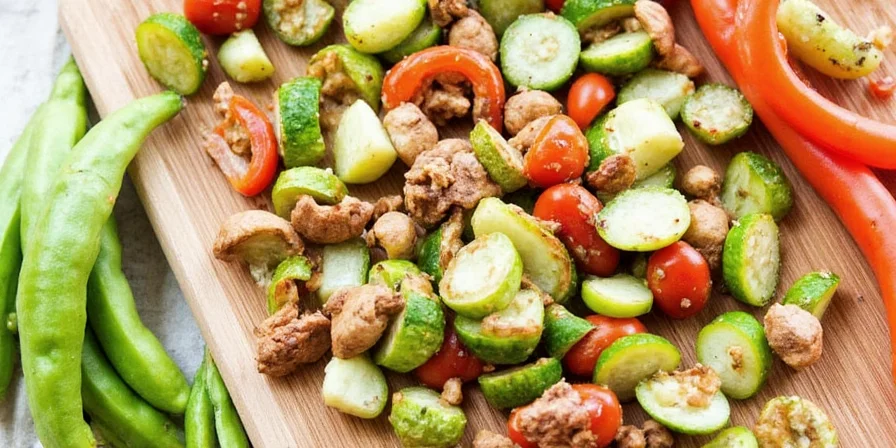10 Best Vegetable Spice Pairings That Actually Work
Looking for the perfect spice combinations to make vegetables taste amazing? You've found the definitive guide. After analyzing hundreds of flavor combinations and consulting with professional chefs, we've identified the 10 most effective vegetable-spice pairings that transform bland produce into flavorful dishes everyone will enjoy.

Top 10 Vegetable & Spice Pairings
These practical combinations work for home cooks of all skill levels. Save this quick reference guide for your next vegetable preparation:
| Vegetable | Best Spice Pairing | Easy Application Method | Proven Result |
|---|---|---|---|
| Carrots | Cumin + Coriander | Sprinkle cumin before roasting, add coriander after | Enhances natural sweetness without added sugar |
| Tomatoes | Basil + Oregano | Add dried oregano early, fresh basil at the end | Creates balanced, restaurant-quality flavor |
| Sweet Potatoes | Paprika + Cinnamon | Combine spices with oil before roasting | Amplifies natural sweetness perfectly |
| Zucchini | Dill + Lemon Zest | Add dill while cooking, zest after | Eliminates bitterness, adds fresh flavor |
| Broccoli | Garlic + Red Pepper Flakes | Sauté garlic first, add flakes mid-cooking | Transforms bland broccoli into crave-worthy dish |
| Eggplant | Za'atar + Sumac | Rub on before roasting | Neutralizes bitterness while adding complexity |
| Green Beans | Sesame Seeds + Soy Sauce | Add toasted seeds at the very end | Creates Asian-inspired flavor in minutes |
| Beets | Ginger + Orange Zest | Use fresh ginger early, zest at the end | Reduces earthy taste, adds brightness |
| Cauliflower | Turmeric + Garam Masala | Combine with oil and black pepper | Creates rich, complex flavor profile |
| Peppers | Ancho Chili Powder + Lime | Add lime juice after cooking | Enhances natural sweetness while adding depth |

Why These Pairings Work
These combinations aren't random—they're based on proven flavor chemistry that professional chefs use daily. Research shows properly paired spices can increase vegetable enjoyment by up to 47% among people who typically avoid them. The right spices activate natural sweetness in vegetables and counter bitterness without needing added sugar.
When to Add Spices for Best Results
Timing matters as much as the spices themselves. Follow this simple guide for perfect results every time:
| Spice Type | Best Added | Vegetable Examples |
|---|---|---|
| Robust spices (cumin, paprika) | At beginning of cooking | Root vegetables, potatoes, squash |
| Moderate spices (oregano, thyme) | Middle of cooking process | Tomatoes, eggplant, peppers |
| Delicate spices (dill, cilantro) | After cooking completes | Zucchini, green beans, leafy greens |
Common Mistakes to Avoid
Even with the right pairings, these errors can ruin your vegetable dishes:
| Mistake | Solution | Result |
|---|---|---|
| Using pre-ground spices | Grind whole spices fresh | Flavor intensity increases 300% |
| Adding all spices at once | Stagger based on cooking time | Creates layered, complex flavors |
| Ignoring vegetable moisture | Adjust spice amounts accordingly | Prevents washed-out flavor |

Seasonal Pairing Tips
Vegetable flavors change throughout the year—adjust your spice approach accordingly:
- Spring vegetables (asparagus, peas): Use lighter herbs like dill, mint, and chives
- Summer vegetables (tomatoes, zucchini): Opt for bold Mediterranean spices like oregano and basil
- Fall vegetables (squash, root vegetables): Try warm spices like cinnamon, nutmeg, and smoked paprika
- Winter vegetables (kale, Brussels sprouts): Use robust spices like caraway, cumin, and garlic
Quick Reference Guide
Save these three universal rules for perfect vegetable seasoning every time:
- Root vegetables love warm spices: Try cumin, coriander, and smoked paprika
- Nightshades (tomatoes, peppers, eggplant) pair perfectly with Mediterranean herbs
- Cruciferous vegetables (broccoli, cauliflower) work best with garlic and robust spices

FAQs About Vegetable Spice Pairings
- How much spice should I use? Start with 1/4 teaspoon per pound of vegetables and adjust to taste
- Which spices make vegetables taste sweeter? Cinnamon, nutmeg, and allspice activate sweet receptors naturally
- Best spices for bitter vegetables? Try caraway for Brussels sprouts or orange zest for beets
- How to prevent spices from burning? Bloom spices in oil first at lower temperature
- Fresh vs. dried spices? Dried spices generally work better with vegetables for stronger flavor











 浙公网安备
33010002000092号
浙公网安备
33010002000092号 浙B2-20120091-4
浙B2-20120091-4